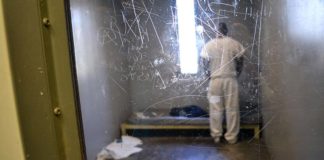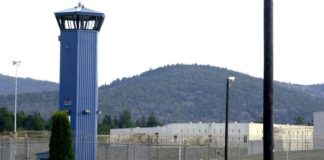Tags Extreme isolation
Tag: extreme isolation
Liberate the Caged Voices
In the wake of deep pain inflicted, this collection of excerpts from prisoners gives testimony to compassion, love, support, integrity, intelligence, faith, heart, depth and humanity from those too often dehumanized.
SHU-shifting update: Relief finally granted to California prisoners experiencing ongoing isolation
On July 3, a critical ruling issued in Ashker v. Brown (aka Ashker v. Governor, Docket No. 4:09-cv-09-5796 CW (N.D. Cal.)), the federal class-action lawsuit challenging indefinite solitary confinement in California. The ruling, issued by Presiding Judge Claudia Wilken, granted Plaintiffs’ appeal on a motion challenging the ongoing conditions of extreme isolation endured by many class members.
Alabama’s mistreatment of prisoners with mental illness has led to a...
Since the beginning of 2018, four people in ADOC custody – three in solitary confinement and one on death row – have died by suicide. The suicide rate in Alabama prisons is one of the highest in the country. In June 2017, U.S. District Judge Myron H. Thompson declared the mental health system in Alabama prisons “horrendously inadequate,” an unconstitutional failure that led to what Thompson called a “skyrocketing suicide rate” among prisoners.
Wrongfully returned to SHU: Six-month update
I begin this six-month update on the activities of CDCR and the CCPOA with my utmost thankfulness and respect for the San Francisco Bay View. I thank your staff and readers for continuing to shine a bright light on the injustices that occur daily behind enemy lines, as it pertains to human beings who are marginalized as prisoners, defined as slaves by the 13th Amendment of the U.S. Constitution, but yet full citizens of this country! I have now been housed in Pelican Bay Level II SHU for six months, and the situation has not progressed but has rapidly deteriorated.
Hunger striking Cornelius Harris in USP Florence, Colo., near death
On Feb. 17, 2016, Ohio state prisoner Cornelius Harris, held in the high security U.S. Penitentiary at Florence, Colo., after being transferred against his will from the state to federal prison system, began refusing meals, vowing not to eat until he is transferred back to Ohio. Recently, he has refused not only food but fluids. Cornelius is sacrificing his health and possibly his life because hunger striking is the only peaceful way he can try to be heard.
Representative or the represented?
Recently, Congresswoman Corinne Brown revealed that white legislators from Florida’s redistricting body changed her district to include the state’s overcrowded but under-represented prisons. If the Congressional Black Caucus had fought for and prevailed on prisoner enfranchisement, Rep. Brown would have no viable argument against her redistricting, for prisoners would be allowed to vote as everyone else.
Eva Contreraz: San Quentin Adjustment Center from my perspective
I was in the San Quentin Adjustment Center (SHU) for four years in the early to mid-1980s. We called it AC. San Quentin was all holes except one block. AC was the deepest hole in San Quentin. It is a short, three-floor, windowed building with two rows of roomy, single-bed cells on each floor, facing the windows. I was there when the first group of Death Row inmates was moved in as overflow. The AC of today is a far cry from that bygone era.
At Ohio’s supermax prison, a hunger strike ends but extreme isolation...
Last week, men incarcerated at Ohio’s supermax prison brought a month-long hunger strike to a close. Between 30 and 40 men had refused all meals since March 16 to protest new restrictions placed on already severely limited recreation and programming for those in solitary confinement. On April 15, all but one of the men agreed to suspend the hunger strike after a meeting with the warden at which the prison agreed to lifting some, but not all, of the new restrictions.
CDCr calls hunger strike supplemental demands reasonable, then reneges; prisoners respond
The Pelican Bay Human Rights Movement wrote 40 supplemental demands to detail what prisoners are entitled to and need to have re-instated. In responding to the California Department of Corrections and Rehabilitaion’s response to our 40 supplemental demands, I would like to get into the actual details of what the CDCr is and is not saying in response to prisoners.
CDCR’s torture affects us all
As can be seen from the LSPC report, “Cage within a Cage: A Report on Indeterminate SHU Confinement and Conditions,” CDCR’s torture has reached beyond just the targeted California indeterminate SHU class imprisoned person and extends into the families and communities as well.










